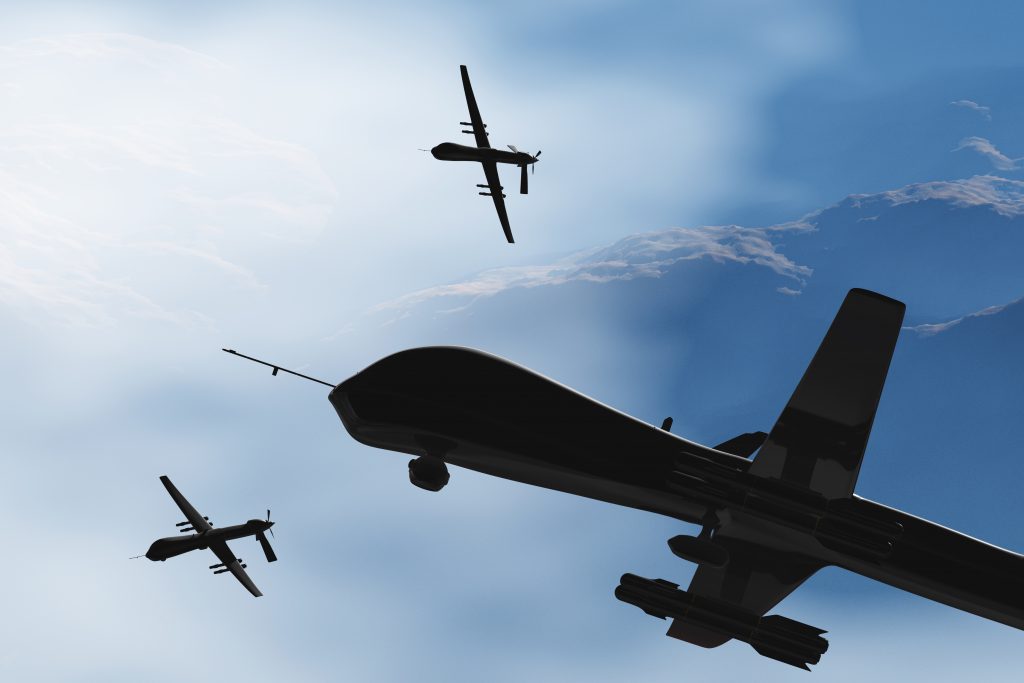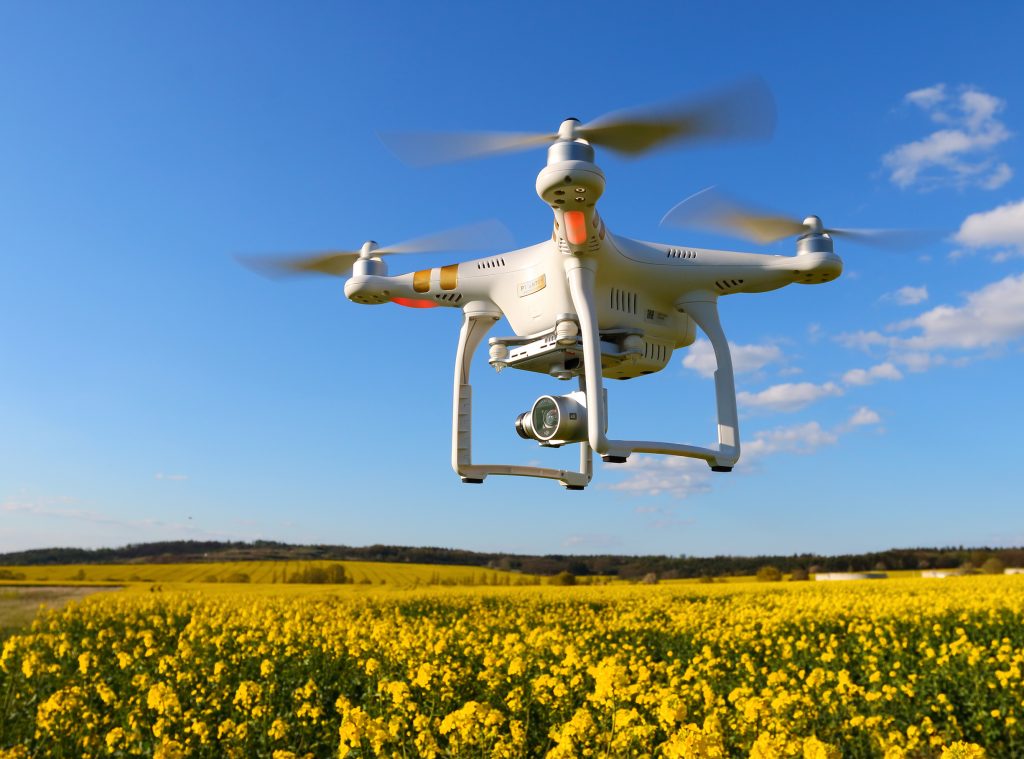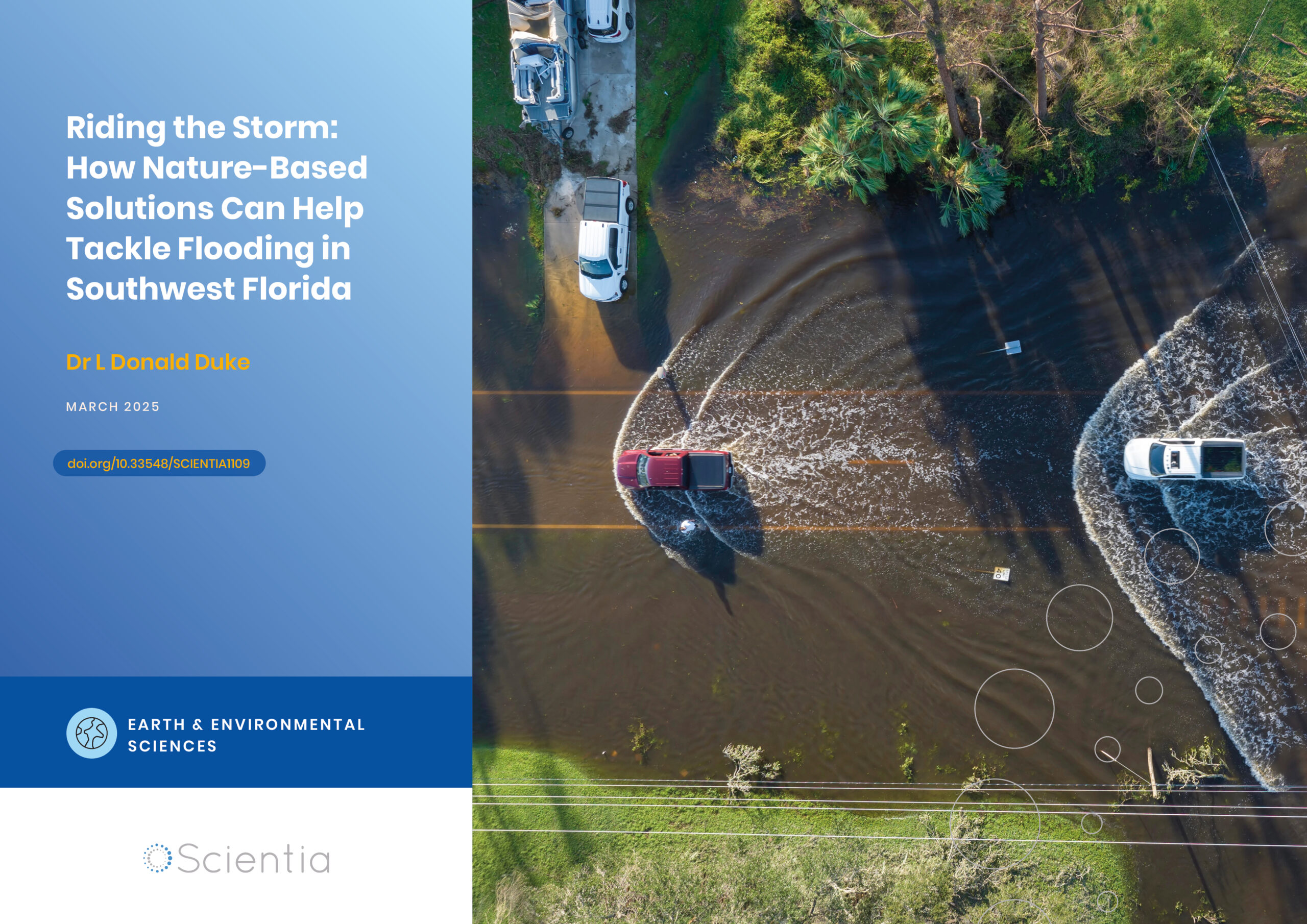SwarmMATE™: Swarming Drones for Real-world Missions
The idea of unmanned drones flying together in expansive swarms may at first sound chaotic and unpredictable – yet with the right approach, these machines can enable their users to carry out coordinated and highly advanced missions. Through their research, John Sauter and colleagues at SoarTech have developed SwarmMATE™ – a transformative software that enables drones to mimic the behaviours of swarming animals found in nature. Their architecture now paves the way for real-world applications – from tracking forest fires and storms to aiding rescue missions.
Complex Swarms
From the seas to the skies, swarms of insects, birds and fish can be found across the natural world. The reasons why these animals collect into swarms can be highly varied – but in every case, properties emerge in these expansive groups that are vastly more complex than any individual animal could conceive on its own. As John Sauter explains, this has led to some highly sophisticated feats of engineering.
‘Natural systems have devised means to coordinate the activities of many simple agents for accomplishing complex tasks,’ he says. ‘Termites build large complex mounds with floors, chambers, arches, and cooling all without the aid of a single architect. Ants can find and build shortest paths from distant food sources to their nests without using a navigation app.’
Although we may not realise it, similar phenomena are also present in our own society. For example, in the markets that drive our economy, the simple acts of buyers and sellers aiming to maximise their own profits each contribute to a deeply intricate financial ecosystem. In each of these scenarios, there is no central authority telling each individual exactly what to do; instead, complexity emerges from sets of simple and intuitive rules, which enable individuals to collectively achieve impressive feats.
Recently, these behaviours have seen increasing interest across a wide variety of fields of research. In their work, Sauter and his colleagues at SoarTech study one particularly fascinating area: swarms of unmanned aerial drones, which work together to carry out complex tasks.
Similarities in Design
In recent years, technological advances have led to cutting-edge designs of compact, lightweight, and inexpensive drones; capable of communicating with each other even as their positions continually change. In principle, these characteristics are ideal for using swarms of drones to carry out complex tasks. However, such an ambitious goal is faced with numerous challenges. ‘Researchers have tried to control these large systems using traditional top-down planning approaches,’ says Sauter. ‘But those approaches simply don’t scale when you are talking about tens, hundreds, or thousands for unmanned systems.’
Within such an intricate web of interacting machines, system designers must determine how individual drones should best contribute to the overall goals of a mission, while also assessing the performance of the overall system. When operating in environments with unpredictable terrains, obstacles, and weather conditions, it can be extremely challenging for designers to come up with plans for each drone that ensure the whole swarm achieves the objectives of the mission.
While studying this problem in the mid-80s, Dr Van Parunak, a colleague of Sauter, turned to natural systems for a possible answer. There, he found many examples of complex swarm behaviours even though individually, the members were not doing anything very sophisticated. Through their analysis of swarms found in nature and human society, Sauter’s team developed advanced algorithms that mimic the ability of groups of animals or insects to overcome these challenges, producing a result much more powerful than the sum of its individual members.
‘By studying these systems, we’ve identified some common design principles that determine how they organise and coordinate their activities,’ Sauter illustrates. ‘We can now create artificial societies in our computers, with many agents operating under simple rules; and train them to solve some really hard problems.’ With over 20 years of experience conducting these tests and studies, the researchers at SoarTech are now well equipped for making the widespread societal use of swarming drones a step closer to reality.

Introducing: SwarmMATE™
The team’s efforts have now culminated in the launch of their tool – Swarming Mobile Autonomous Teaming Environment (SwarmMATE™) – first introduced in 2017. This advanced framework addresses four core challenges associated with drone swarm design and deployment: firstly, it breaks down the overall goals of a mission into sets of smaller tasks that can be performed by a single drone or team of drones. Secondly, the software determines the sizes of swarms to fit the needs of the mission. Thirdly, SwarmMATE™ has tools to measure and verify that the swarm behaviours are consistent with the goals of their mission, to a high degree of confidence. Finally, DSOARS includes an execution framework that enables a highly distributed swarm to communicate and coordinate using the swarming algorithms developed by SoarTech.
Together, these measures enable engineers to develop high-performance drone swarms that are robust against obstacles, and which can adapt to dynamic, unpredictable conditions in the field. By following the algorithms built into the software, drones can both cover larger areas within regions that would be hard to reach from the ground, while performing more coordinated manoeuvres to maximise the amount of information they gain.
‘Through our research, we have developed a truly revolutionary software architecture that encapsulates the best of what I’ve learned about swarm intelligence and control,’ Sauter describes. ‘SwarmMATE™ is a platform that coordinates the behaviours of groups of robots performing a range of missions.’ With these measures in place, Sauter’s team could next focus their attention on applying drone swarms in specific scenarios.
Real-world Missions
By fitting drones with scientific instruments such as sensors and cameras, they can become highly sophisticated tools in the coordination of advanced, potentially dangerous missions. Such a system now displays clear potential for immense societal benefits. ‘We aim to coordinate robotic swarms for performing missions that are useful for human society,’ describes Sauter. ‘We can scale from just a few robots to massive swarms comprising thousands of robots using the same algorithms, so we can solve both the small and really large problems we face.’
These capabilities have already been explored for military applications – but increasingly, the SoarTech team have come to examine the immense societal benefits they could soon unlock. ‘A common theme among these missions is the need to cover large, irregularly shaped, dynamically changing areas,’ Sauter continues. ‘Swarms are an ideal way to organise a team of vehicles to distribute the tasking, and dynamically adapt to changing mission requirements.’ Among the many applications this enables is the tracking of forest fires and severe weather; informing search and rescue operations; and monitoring agricultural crops.
Mapping Forest Fires
Forest fires have grabbed many headlines in recent years – unleashing widespread devastation both on natural environments, and the communities living within them. In the face of this threat, there is a pressing need for firefighting operations to monitor and map the spread of fires in real time, to determine where and how quickly the fire is moving and where best to deploy limited firefighting resources. As Sauter describes, SwarmMATE™ algorithms can coordinate drone swarms to perform these functions.
‘We developed swarming algorithms to control a swarm of air vehicles with thermal sensors to search a large, mountainous, forested area for forest fires,’ he says. ‘This involved finding the hot spots, patrolling around the perimeters of fires, mapping their extents, and then continuing to track and update maps of their perimeters as they spread.’ By consulting these maps, authorities would be far better equipped to direct firefighting teams to combat blazes as efficiently as possible.

Tracking Severe Weather
Through further studies, Sauter’s team has shown how swarms can also be used to monitor extreme weather events – which can take place over expansive areas and ranges in altitude. Their techniques enable far more sophisticated measurements than those made by traditional instruments such as weather balloons and dropsondes dropped from manned aircraft, which have extremely limited monitoring ranges and operation times.
When equipped with weather sensors, swarming drones can smartly organise themselves into positions that give them the best possible meteorological data. ‘Data needs to be collected on wind speeds, direction, temperatures, pressure and humidity, to better predict the severity and direction a storm,’ Sauter illustrates. ‘The swarm has the intelligence to adapt to the changing weather patterns as it moves across a region, ensuring continuous coverage and tracking.’ In turn, this will enable meteorologists to generate far better forecasts of how storms will progress over time, giving communities time to prepare.
Informing Search and Rescue
Fast, thorough search techniques are particularly crucial for saving lives in search and rescue operations. Whether searching for hikers lost in the wilderness, or victims caught in disaster zones, these operations will often involve scanning expansive, remote, and possibly dangerous regions with difficult terrain. These are extremely difficult to cover extensively using manned aircraft – but are far less of an issue for intelligent drone swarms.
‘An intelligent swarm of vehicles can cover a much broader area in a shorter time than manned aircraft and for much less cost,’ says Sauter. ‘They can fly closer to the ground and peer deep into valleys where it is difficult for manned aircraft to reach.’ Equipped with tools such as infrared sensors, radar and radios, these swarms can search remote areas for signs of human life, while also providing cellular connectivity where there isn’t otherwise any service available – allowing victims to communicate their positions.
Monitoring Agricultural Crops
As farmers around the world aim to improve the sustainability of their agricultural practices, while maintaining high yields to meet growing demands for food, they are increasingly seeking to minimise their use of chemicals and resources. Using drone swarms fitted with cameras capturing a wide region of the electromagnetic spectrum, they can scan large areas of farmland in a short space of time; identifying any areas where crops are suffering from factors such as insect-related disease or water stress.
As a result, these farmers can pinpoint exactly where additional water or chemical applications are needed. ‘A swarm of drones can then deliver just the right kinds of chemical only when and where it is needed, instead of the current practices of broadcasting these chemicals everywhere as a preventative measure,’ Sauter explains. This would enable farmers to greatly reduce the environmental impact of their operations – both reducing water usage in their local regions, and making fields more friendly to plants and animals that pose no threat to crops.

Diverse Societal Benefits
While intelligent drone swarms hold the potential to transform operations in each of these areas, the full extent of their capabilities extend far further still – ranging from law enforcement and drug interception, to logistics and traffic monitoring. In the future, Sauter and his colleagues at SoarTech will continue their efforts to expand the reach of their SwarmMATE™ software in numerous aspects of society. Ultimately, the team hopes that the benefits enabled by swarming drones could soon become a key feature of our everyday lives.
Reference
https://doi.org/10.33548/SCIENTIA707
Meet the researcher

John A. Sauter
Soar Technology, Inc.
Ann Arbor, MI
USA
John Sauter has over three decades of experience in research and development. He has a particular interest in using artificial and swarm intelligence for the control of complex systems – including systems of multiple vehicles, and the scheduling and control of distributed logistics. Sauter has served as Principal Investigator on numerous projects at DARPA, where he pioneered the development of one of the first swarming algorithms enabling fully distributed control over multiple unmanned vehicles. He has worked at Soar Technology, Inc (SoarTech) since 2013, where he is Director of Autonomy. Sauter is also an Instructor for the Unmanned Vehicle University, where he designed and teaches the graduate-level course, Autonomous Unmanned Systems.
CONTACT
E: john.sauter@soartech.com
KEY COLLABORATORS
Dr VanParunak, ABC Research
Kellen Bixler, SoarTech
FUNDING
DARPA
AFRL
NAVAIR
US Army
FURTHER READING
JA Sauter, K Bixler, S Kitchen, R Chase, RF emitter localization with robotic swarms, In Unmanned Systems Technology XXII, 2020, April (Vol. 11425, p. 114250D), International Society for Optics and Photonics.
JA Sauter, K Bixler, Design of unmanned swarm tactics for an urban mission, In Unmanned Systems Technology XXI, 2019, May (Vol. 11021, p. 110210K), International Society for Optics and Photonics.
JA Sauter, K Bixler, SwarmMATE™: a swarm engineering and verification environment, In Unmanned Systems Technology XXI, 2019, May (Vol. 11021, p. 110210N), International Society for Optics and Photonics.
![]()
Want to republish our articles?
We encourage all formats of sharing and republishing of our articles. Whether you want to host on your website, publication or blog, we welcome this. Find out more
Creative Commons Licence
(CC BY 4.0)
This work is licensed under a Creative Commons Attribution 4.0 International License. 
What does this mean?
Share: You can copy and redistribute the material in any medium or format
Adapt: You can change, and build upon the material for any purpose, even commercially.
Credit: You must give appropriate credit, provide a link to the license, and indicate if changes were made.
More articles you may like
Dr Ying Zou | A New Type of Space Storm: The Extraordinary Auroral Event of April 2023
Space weather events can have dramatic effects on Earth’s magnetic field, potentially disrupting everything from power grids to GPS systems. Dr Ying Zou and her colleagues Dr Jesper Gjerloev and Shin Ohtani from Johns Hopkins University Applied Physics Laboratory led a groundbreaking investigation into an extraordinary disturbance in Earth’s magnetic field that occurred in April 2023. This unprecedented event is reshaping our understanding of how solar activity can trigger extreme space weather that impacts our technological systems.
Dr L Donald Duke | Riding the Storm: How Nature-Based Solutions Can Help Tackle Flooding in Southwest Florida
Florida grapples with mounting challenges related to inland flooding due to heavy precipitation, along with coastal flooding from rising sea levels and coastal storms. One important approach to address precipitation-originating flooding is to embrace land use practices runoff management in the upstream portions of at-risk watersheds, where sustainable design can relieve the pressures on drainage systems from continuing dense urban development in the low-lying Florida landscape. Dr L Donald Duke, from The Water School at Florida Gulf Coast University, plays a pivotal role in this endeavour. His work encompasses creating and evaluating flood-resilient land use practices and planning to manage stormwater runoff on the watershed scale.
Professor James Calvin | Innovation in Heart Failure Care: Comparing Personal Coaching with Digital Support
Heart failure remains one of the most challenging conditions facing healthcare systems today, with hundreds of thousands of new cases diagnosed annually. Professor James Calvin from Western University’s Schulich School of Medicine and Dentistry has led groundbreaking research comparing two innovative approaches to supporting patients: personal health coaches and smartphone reminders. His team’s findings suggest that combining human support with digital technology could transform how we help patients manage this complex condition.
Dr Hermann Salmhofer | Minimising the Damage Caused by Systemic Viral Infections
The mechanisms via which viral diseases infect and progress within the human body have become the subject of intense scrutiny since the emergence of the serious respiratory condition COVID-19, although many other viruses remain woefully under-researched. Recently, Dr Hermann Salmhofer and colleagues at the Paracelsus Medical University in Salzburg, Austria, have described the successful treatment of a harmful systemic virus affecting the kidneys, and suggest a possible new treatment target to mitigate the progression of the disease and prevent the development of permanent organ damage. Their findings, combined with broader research on viral infections, highlight the critical importance of both preventive measures and targeted treatments in managing viral diseases.




